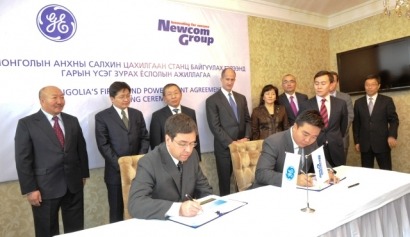
The $100 million project will be located 70 kilometres southeast of Ulaanbaatar, Mongolia’s capital city, and is set to open in 2012.
The entry into Mongolia is a strategic move by GE that recognizes the burgeoning demand for renewable energy in growing regions around the world - including Asia, Africa and Latin America.
Mongolia’s electricity demand is expected to double in the next 15 years. The GE turbines powering Salkhit Wind Farm will generate nearly 5 percent of Mongolia’s current electricity.
GE’s involvement in the Salkhit Wind Farm project includes equipment supply and technical assistance in the installation and commissioning of the wind turbine generators for the generation of wind energy.
GE was represented at the signing ceremony by John Rice, Vice Chairman and CEO of GE’s Global Growth & Operations. He was joined by Bayanjargal Byambasaikhan, CEO of Newcom.
“Energy demand in Mongolia is increasing by 8-10% a year,” said Byambasaikhan. “Salkhit will help support Mongolia’s growing demand and also help facilitate further infrastructure development for railway, road and electrical infrastructure.” In 2005, Mongolia’s parliament approved the National Renewable Energy Program, which aims to increase the country’s renewable energy share to 20-25% by 2020. Mongolia’s current installed capacity is roughly 800 MW.
Rice, meanwhile, described the agreement as a “milestone” in the development of GE’s relationship with Mongolia and with Newcom.
“We are introducing advanced technology that paves the way for renewable energy projects and underscoring our commitment to grow in one of the most challenging yet fastest-growing emerging regions,” Rice said.
Mongolia is becoming one of the world’s fastest growing economies, registering the highest growth in the world at 17.3 percent by 1H 2011 year on year, according to the World Bank.
Energy demand is expected to double by 2015. Salkhit Wind Farm will supply 168 million kW.h of clean power to the national grid each year. It will also cut CO2 emissions by 185,000 tons and preserve 1.6 million tons of fresh water annually.
For additional information:

